Project Log: Sunday, July 25, 2010
We got an early start to travel the 350 miles to
Newburgh, NY, where the boat was located. I was
very excited to see the boat: I'd actually never
laid eyes on a Fisher before, except for a 38 Trawler
owned by the owner of a marina where I once worked.
So even though I'd harbored a discreet infatuation with
the brand for years, I really had no idea what to
expect.
In the days leading up to this visit, I'd spent every
spare moment online researching Fisher 30s and
collecting every photo I could find. To me, the
biggest question mark in terms of whether the boat would
be right for us was the cockpit, and how liveable it was
in terms of lounging comfort. When cruising, I
like to spend time outdoors, much of it in the cockpit
reading, eating, or just enjoying the view.
We arrived at the owner's home--where the boat was being
stored--around 1100, right on schedule. It was a
sultry summer day, and the temperature in the sun was
well into the 90s. The boat was covered with blue
shrinkwrap as far aft as the pilothouse, so at least the
cockpit was open. On the way, we'd discussed
whether we'd ask the owner to unwrap the boat for our
inspection, but ultimately I decided against it. |

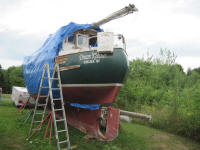 |
We spent some time talking with the owner before truly
getting into the necessary inspection. I found out
the circumstances behind the boat's sinking: the
owner had removed the original engine, a 3-cylinder
Volvo diesel, for a top-end rebuild while the boat was
in the water. With the exhaust disconnected, water
siphoned into the boat through the exhaust outlet, which
was located just above the waterline about 1/3 the way
forward on the starboard side. The owner reported
that he received a call from his yacht club one day
telling him that the boat looked low. While he was
getting himself down to the boat, about 1/2 hour
distant, he received another call: "Actually, you
don't need to rush now, because she's gone".
Later, the owner dived on the boat to secure a number of
air bags, which, when filled, raised the boat to the
surface, where she could be pumped out. The boat
was powerwashed to remove most of the river silt and
mud, then placed into storage, which is how she remained
for a couple years. |
 |
There were several active wasps' nests on the boat,
located in strategic places, and this, coupled with
stifling heat inside the covered boat, made for
less-than-ideal inspection circumstances. It was
easy enough to get inside the boat despite the heat, but
everything was tinged with blue from the cover, and it
wasn't a very pleasant experience. |


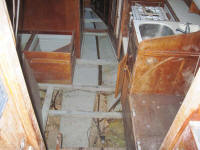
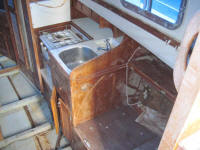
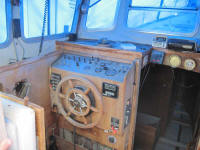


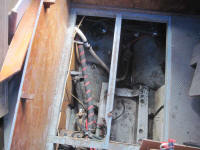 |
I managed to squeeze myself through the narrow opening
between the pilothouse and shrinkwrap to get up to the
bow and inspect the decks, but I didn't spend a lot of
time up there. |
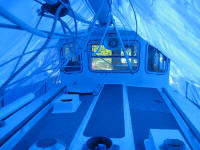
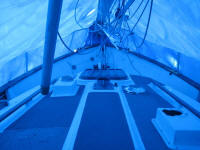 |
In all, we spent about two hours at the boat. We
liked her, though clearly she required a lot of vision
to get past her current condition. Heidi had a few
reservations about the interior, though mainly because
it hadn't necessarily met her expectations in terms of
space and layout, though later on she was to change her
mind after looking through all the Fisher 30 pictures
I'd collected from the Internet.
After a day or two of discussion, we decided to make an
offer, which the owner accepted. I sent off a
deposit to hold the boat, and made arrangements to truck
the boat back to the shop on August 24. |
| |
Total Time Today: n/a |
<
Previous | Next
> |
|
|














